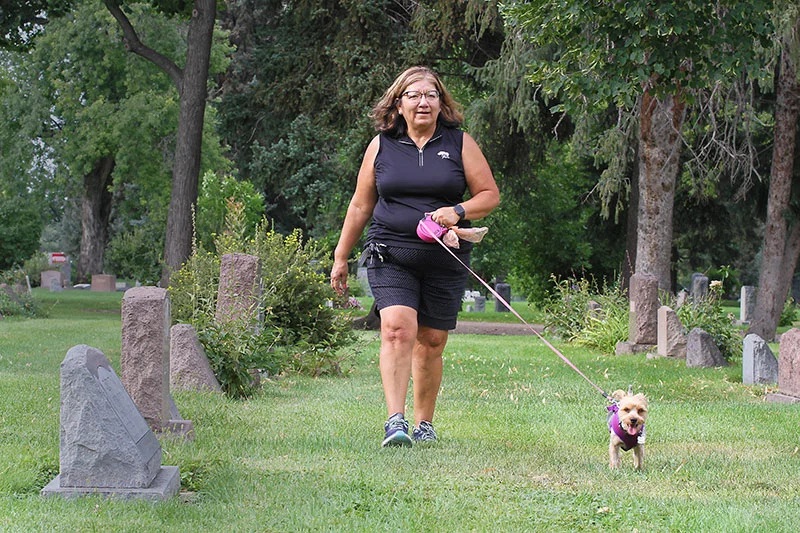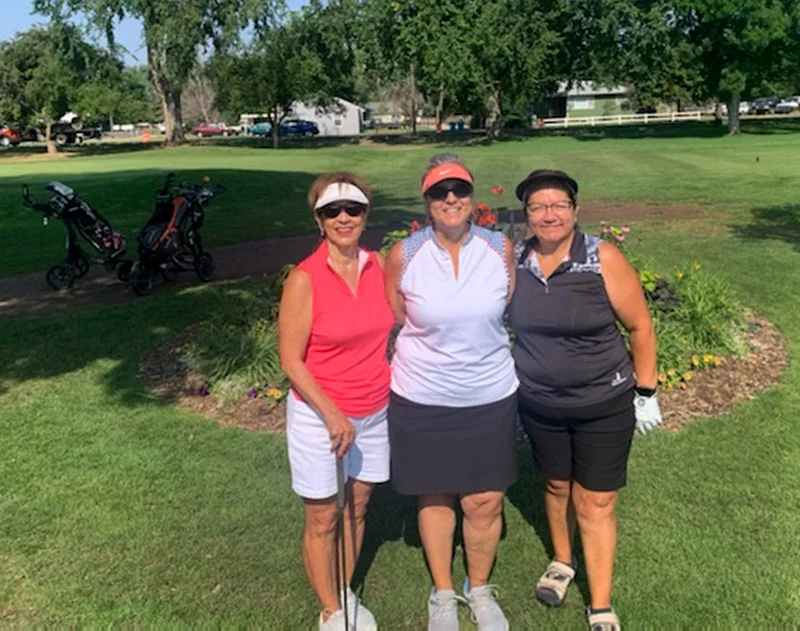
Gloria Miller felt “ragged” after she retired from 40 years as a manager with Safeway. She’d spent her whole career on her feet, logging mile after mile, long before it became hip to count steps. She always grabbed a quick deli meal when she could while on the go, but in retirement, she knew she needed to take better care of herself.
Driving her desire for change was the memory of her mother, Isabelle Gavaldon, a strong Hispanic woman who raised 11 kids on her own. Gloria is the eighth youngest. Gavaldon died in 2002 at the age of 72 after a decade of battling all sorts of health problems, including Type 2 diabetes.
These days, Miller makes a daily trek through Grandview Cemetery in Fort Collins, where her mother is interred. She stands at her mom’s graveside, with Marley, her Yorkie puppy, and talks with her mom about her desire to grow stronger and healthier.

“I made a promise to myself that when I turned 72, I’d be physically fit, and my A1C (blood-sugar level) would be down where it should be,” Miller said. “I wanted to show my mom that I was going to be healthier.”
After retiring in 2016, Miller downloaded the MyFitnessPal app to her phone to track calories, and she cut salt from her diet. She’d always enjoyed being on the go, so she turned that energy into more walks and golfing nine holes several times a week. It wasn’t enough. At 65, she needed something more to decrease her blood sugar and set her on a path of success if she were to keep her promise.
In January 2021, she found the extra boost she needed — a “nutrition class,” as she likes to call it, through UCHealth — and she feels better than ever.
Type 2 diabetes and genetics
Adults have a 40% chance of developing Type 2 diabetes over their lifetime. But for Hispanic and Latino adults, it is a 50% chance.
“Being Hispanic and knowing diabetes is in our DNA, we need to be conscious of what we do,” Miller said.
After a visit to her primary care doctor in the fall of 2020, Miller found out she had prediabetes, meaning her blood sugar was high (A1C between 5.7% to 6.4%) but not high enough for a Type 2 diabetes diagnosis. Her physician told her that she qualified for the Diabetes Prevention Program.
The Diabetes Prevention Program is a Center for Disease Control and Prevention lifestyle change program, proven to prevent or delay Type 2 diabetes. UCHealth Northern Colorado is a fully recognized program provider. Programs with full recognition are required to meet performance standards, and show their participants are meeting program goals for weight loss, physical activity minutes, and decrease in A1C. An A1C in the prediabetes range is one criterion for enrollment, as well as other health risks. The program is a once-in-a-lifetime covered benefit by Medicare B and C. And the program is a covered benefit for UCHealth employees and beneficiaries who are enrolled in the UCHealth Anthem medical plan.
“My doctor had me sit down with a UCHealth DPP coach, who explained everything and sent me home with information about it,” Miller said. “I decided I needed to do this — I needed to change the way I looked at food and eat healthier.”
Joining a Diabetes Prevention Program (aka nutrition class)
Unlike Type 1 diabetes, a condition in which the pancreas produces little or no insulin, Type 2 diabetes arises when the body doesn’t produce enough insulin and stops using it properly — often called insulin-resistant diabetes. Type 2 is the most common form of diabetes and most people who have it have metabolic syndrome, with elevated blood sugar, high blood pressure, high cholesterol, and increased abdominal girth.
Type 2 is treated with lifestyle changes and often requires medication and insulin to keep blood sugar under control.
The next classes start in February and April 2023. To learn more about prediabetes classes in northern Colorado and if you qualify for Diabetes Prevention Program, call Teresa at 970.495.8777.
Learn more about diabetes classes near you in other areas of Colorado.
Medicare covers the Diabetes Prevention Program under Part B or C (Medicare Advantage) as a once-in-a-lifetime benefit.
The program is also a covered benefit for UCHealth employees and beneficiaries who are enrolled in the UCHealth Anthem medical plan.
The good news: A weight loss of as little as 5% can lower the risk for developing Type 2 diabetes by 58%. That reduction jumps to 71% for those over the age of 60, according to National Diabetes Prevention Program research.
The program goals are to increase physical activity to at least 150 minutes per week and achieve a weight loss of 5% of their starting body weight.
UCHealth is offering virtual classes at this time.
“I’m in the class right now and love it,” Miller said of her virtual class. “It got me focused.”
Why take a diabetes prevention class?

Miller started her virtual Diabetes Prevention Program in January 2021. She met weekly with her group for the first 13 classes, covering nutrition and physical activity, with a strong focus on making lasting behavioral changes.
“It changed the way I looked at food,” she said. “Like portion sizes, I didn’t pay attention to that until this class. I used my Fitness Pal before to track calories, but now I look at everything, and I have a better understanding of what’s good for me and what’s bad.”
It changed the way she shops for food as well.
“I worked 40 years in a grocery store, so I always shopped up one aisle and down the other, aisle by aisle. I’d go into the produce section thinking I’d make a salad and grab just a few things,” she said. “Instead of walking the aisles, now I walk the perimeter of the store — only produce and dairy — staying away from the bakery and deli. I no longer shop the aisles unless there is something I ran out of, like flour.
“When I worked there, it was so easy to go to the deli. I didn’t think about it because I was constantly moving, but all those years, I was eating bad,” Miller said. “I just thought because I was constantly moving and lifting, I didn’t need to worry about it.”
Her new nutrition class began yielding results, giving her more motivation.
“I saw changes in my endurance,” she said. “I had the energy to golf and then come home and take my dog for a walk. I wasn’t overly tired anymore.”
Miller, who turned 66 on Aug. 15, 2021, loves to walk her 9-hole course, golfing as much as five times a week. Along with her annual golf tournament birthday bash, she has regular tee times with her friends and siblings, who have started walking with her.
Her friends and siblings have also followed her lead when it comes to the skills she’s learned in her new “nutrition class.”

Although her boyfriend does most of the cooking at home, Miller started buying new things for him to use. She now cuts up carrots and celery for an easy grab-and-go snack. He’s followed her advice and started using an outdoor griddle instead of pan-frying food. He’s steaming vegetables instead of sautéing, substituting yams or sweet potatoes for baked potatoes, and limiting meats high in fat.
“It is progression and daily work,” she said. “I probably would have been OK without this class, but now the alarms go off in my head — yes, you can eat that or no, you shouldn’t do that — and it keeps me moving so I’m not sedentary so much.”
Taking the Diabetes Prevention Program virtually
After the first 13 weeks, the class met less frequently, every two weeks, then every three weeks, and then monthly through the rest of the year. She continues to write a diary of her daily achievements and challenges, writing she shares with the class.
“I like the virtual class,” Miller said. “It’s convenient at home as I don’t have the chore of having to go into a meeting. I get excited about 45 minutes before, so I go to my computer and get everything set up, so I don’t have any issues.”
Meeting with her class virtually hasn’t hindered the bond she’s formed with her classmates either, she said.
“When we sign on to class early, we start to talk to each other,” Miller said. “During class, we take turns reading and talking about our previous week. There is not one intimidating person, and I think it’s because the people in the class want to be there, so there is no negativity. There is so much positivity. You get energized from the class, from what people say and the recipes they share.”
Her instructor, Julie Gormley, helps facilitate that positive environment, she said.
Gormley is the Diabetes Prevention Program coordinator and lifestyle coach, as well as a registered dietitian and certified diabetes care and education specialist with UCHealth Diabetes and Medical Nutrition Therapy in northern Colorado.

“Our instructor is awesome — I can’t speak more highly about her,” Miller said. “She keeps the class together and involved. She provides positive feedback when we’ve had a rough week and it didn’t go the way we wanted it. Even if you thought you had a bad week, she turns that around and says, ‘That’s OK, now you know what you did, and you can change that.’”
As a student, Miller said she has always found it easy to fall behind, but that hasn’t been the case with this program.
“The material given is good. The class is just so easy to follow,” she said. “I’ve done other programs but have lost interest. This program is different because I look at food differently, and I don’t mind talking about it. I tell people, ‘I’ve got this great nutrition class, and I love it.’”
Reinforcing her goals and motiving herself to be healthier
With help from the program, Miller is well on her way to keeping that promise to herself. She’s proud of what she’s accomplished over the past few years, and she knows who else would be too — her mom.
Each day, she makes the one-mile walk through Grandview Cemetery and stops to visit her mom and honor her memory.

“I go talk to her — that’s reinforcement for me: ‘Hey mom, I’m doing this and I’m going to be healthier,’” Miller said.
This article was first published on Aug. 27, 2021. Information about the Diabetes Prevention Program was updated on Dec. 1, 2022.
